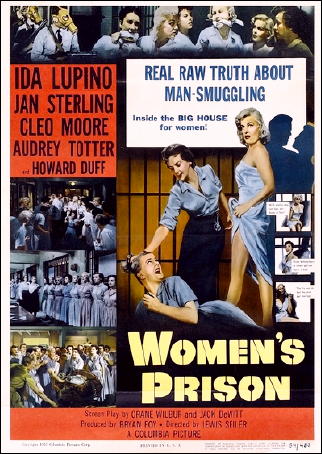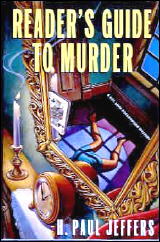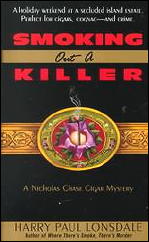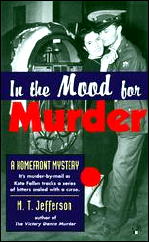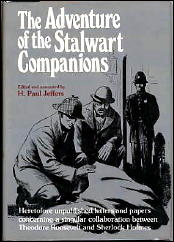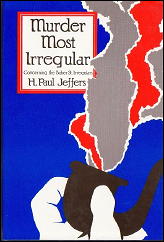December 2009
Monthly Archive
Wed 9 Dec 2009
REVIEWED BY GEOFF BRADLEY:
GUNRUSH. Made-for-TV movie: ITV, 23 August 2009. Timothy Spall, Deborah Findlay, David Harewood, Paul Kaye. Teleplay: Richard Cottan. Director: Richard Clark.
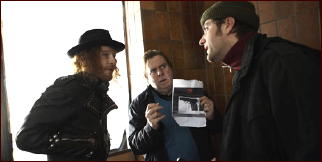
This was a highly touted production with gushing previews in The Radio Times about the state of Britain today and serious dramas about the common man standing up against the threat of teenage hoodlums out to destroy the British way of life.
In fact it was silly nonsense with outrageous stereotypes behaving in a ridiculous manner, with unbelievable story lines. It was probably supposed to be real life rather than “crime drama,” but the story asked you to accept such ridiculous behaviour from so many characters, including the police, and used outrageous coincidence that it was unbelievable.
The story was about how the teenage daughter of a middle-aged couple in London was fatally shot by two disaffected black youths while queuing to buy goods in the local store. The father (Timothy Spall, center above), dismayed by the thought that police weren’t acting, stole evidence and then set out to find the culprits himself, leading to a violent — and wholly unbelievable — conclusion.
Poor stuff.
Wed 9 Dec 2009
Posted by Steve under
ReviewsNo Comments
A REVIEW BY MARYELL CLEARY:
JUNE THOMSON – Sound Evidence. Doubleday Crime Club, US, hardcover, 1985. UK edition: Constable, hc, 1984.
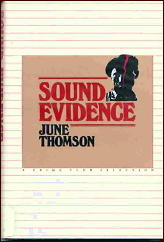
Detective Chief Inspector Jack Rudd is back looking into the puzzling case of the murder of an unidentified young man who has been camping in a house due for demolition. Rudd is also struggling with his attraction to the locum for the police surgeon, Marion Greave, a compassionate woman who is ready to be his friend.
Thomson draws her people with care. There’s young, handsome Ray Chivers, amoral and out for what he can get. There’s lonely old Stanley Aspinell, whose one recreation is chess, and one interest a vacant house, Holly Lodge.
There’s Hugo Bannister, well-to-do civil servant with a fatal weakness for young, attractive men. There’s Sergeant Munroe, fresh from London, who’s sharp and knowing it, and who raises the hackles of Rudd’s more pedestrian Sergeant Boyce.
The story is built with quiet care: the homosexual affair, the robbery and murder, the missing money, the brutal murders. The suspense is spoiled by an early telegraphing of the murderer’s identity, and Thomson’s low-key approach keeps the excitement down.
Still, a good read.
� Reprinted from The Poisoned Pen, Vol. 6, No. 4, Fall 1986
(very slightly revised).
Editorial Comment: Previously reviewed by Maryell Cleary on this blog was June Thomson’s Not One of Us, the first book in the “Inspector Rudd” series.
Wed 9 Dec 2009
REVIEWED BY WALTER ALBERT:
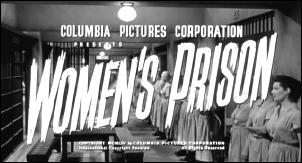
WOMEN’S PRISON. Columbia, 1955. Ida Lupino, Jan Sterling, Cleo Moore, Audrey Totter, Phyllis Thaxter, Howard Duff, Warren Stevens, Gertrude Michael, Mae Clarke, Barry Kelley, Vivian Marshall, Adelle August, Juanita Moore, Ross Elliott, Murray Alper, Frank Jenks, Lorna Thayer, Eddie Foy III. Director: Lewis Seiler. Shown at Cinecon 40, Hollywood CA, September 2004.
In the midst of the corny but eminently watchable antics at a coed prison, Audrey Totter gives a touching performance (with a deathbed scene to boot) and was the last of the Career Achievement Award honorees to appear and be interviewed after the screening.
Lupino is the psychotic women’s superintendent constantly sparring with her (at the time) real-life husband Howard Duff, playing the prison doctor with a big heart for the incarcerated dames.
I was surprised to note that Eddie Foy III was in the cast (I don’t remember seeing his unforgettable kisser in the film) but Sterling, Moore (Juanita and Cleo), and Thaxter all manage to establish their presence among the large cast, and when Lupino goes bonkers, I almost melted from pure joy. (I don’t remember her as being this deliciously over-the-top since her big courtroom scene in They Drive by Night.)
Tue 8 Dec 2009
A 1001 MIDNIGHTS Review
by Bill Pronzini:
H. PAUL JEFFERS – Murder on Mike. St. Martin’s Press, hardcover, 1984. Ballantine, reprint paperback, 1988. Júcar, Colección Etiqueta Negra nº21, 1987, Barcelona, as Muerte al micrófono.
A small but persistent trend in recent years is the retrospective private-eye novel — the nostalgic adventures of PI’s operating in the Thirties and Forties, contemporary recreations of a bygone era.
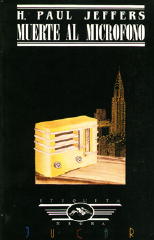
Andrew Bergman, Stuart Kaminsky, and Max Allan Collins have each done quite well with Chandleresque heroes of this sort; judging from the two Harry McNeil novels published to date — Rubout at the Onyx Club (1982) and Murder on Mike — H. Paul Jeffers will, too.
McNeil is a very likable character, “an ex-cop who’s now a private investigator who’d prefer nothing better than to play clarinet with a top jazz band and leave the detective work to better guys,” a shamus who uses his head and his legs and his heart in lieu of violence. Harry McNeil, “the help of the hopeless.”
It is a few days before Christmas, 1939. Harry is in his office above the Onyx Club on Fifty-Second Street, New York City. Enter Maggie Skeffington, a radio actress on “Detective Fitzroy’s Casebook” on the Blue Network (NBC).
A few days earlier, Derek Worthington, the star of the show and a man heartily disliked by his co-workers, was shot to death in Studio 6B at Radio City; and Maggie’s boyfriend, announcer David Reed, has been arrested for the crime. Maggie is convinced that David is innocent, even though he is the only member of the cast and crew who does not have an airtight alibi for the time of the shooting.
Harry takes the case, of course. And meets the various suspects: J. William Richards, owner of the Mellow-Gold Coffee Company and the show’s sponsor; Miles Flanagan, the producer; Veronica Blake, the head writer (with whom Harry later has an affair); Jason Patrick, Worthington’s costar; Rita DeLong, an aging musician; Guff Taylor, the engineer; and Jerry Nolan, the expert sound-effects man.
Any of the lot might have killed Worthington — except for those alibis. The key to cracking the case lies with young Robby Miller, a Radio City tour guide, who heard the fatal shot fired through a studio mike someone inadvertently left open and who has turned up missing….
The mystery here is lightweight but entertaining — until its resolution. The final unmasking, which Harry brings about in Studio 6B on Christmas day with the aid of a self-written radio script, is far-fetched and highly derivative of a famous novel by a certain popular Golden Age writer.
That part of Murder on Mike is disappointing. Still, there is Harry. There is New York at Yuletide 1939, “a city for dreamers because it was a city that could make dreams come true,” a city full of fascinating real-life characters — Winchell, Woolcott, Ed Sullivan, and comedian Fred Allen (both of whom have speaking parts), dozens more.
There is an equally fine evocation of the world of dramatic radio (a subject Jeffers knows intimately: He works for a Manhattan radio station). And there is a nice, old-fashioned flavor to the narrative, a feeling that you are reading a combination of whodunit and bittersweet private-eye romance written in 1939.
———
Reprinted with permission from 1001 Midnights, edited by Bill Pronzini & Marcia Muller and published by The Battered Silicon Dispatch Box, 2007. Copyright © 1986, 2007 by the Pronzini-Muller Family Trust.
H. PAUL JEFFERS, R. I. P. (1934-2009). According to a short online obituary in the Pottstown (PA) Mercury, H. Paul Jeffers died on Friday, December 4th, in Manhattan.
Besides his fictional work (see below), in the 60s he was a Fulbright Scholar in the 1960s and reported from Vietnam with Peter Jennings. He later wrote news for WINS, WABC, WNBC, and WCBS, all in New York City. His non-fiction work included books on history, Westerns and biographies, including books on Theodore Roosevelt and Sherlock Holmes.
The covers and titles of the books below may give you an idea of the wide range of his interests. If his non-fiction were to be included, the range would be even wider.
The Harry MacNeil series:
1. Rubout At the Onyx (1981)
2. Murder On Mike (1984)
3. The Rag Doll Murder (1987)
The Morgan western series:
1. Morgan (1989)
2. Blood On the Nueces (1989)
3. Texas Bounty (1989)
The Sergeant John Bogdanovic series:
1. A Grand Night For Murder (1995)
2. Reader’s Guide to Murder (1996)
3. Corpus Corpus (1998)
The Arlene Flynn series:
1. What Mommy Said (1997)
The Nick Chase series, as by Harry Paul Lonsdale
1. Where There’s Smoke, There’s Murder (1999)
2. Smoking Out a Killer (2000)
3. Up in Smoke (2001)
The Kate Fallon series, as by M. T. Jefferson
1. In the Mood for Murder (2000)
2. The Victory Dance Murder (2000)
3. Decorated for Murder (2002)
Other Novels:
Adventures of the Stalwart Companions (1981)
Murder Most Irregular (1983)
Portrait in Murder and Gay Colours (1985)
Gods and Lovers (1989)
Secret Orders (1989)
Owlhoot Trail (1990)
Tombstone Revenge (1991)
The Forgotten Adventures of Sherlock Holmes (2005)
The Further Adventures of Sherlock Holmes: The Stalwart Companions (2010)
Tue 8 Dec 2009
Posted by Steve under
Reviews[3] Comments
IT’S ABOUT CRIME
by Marvin Lachman
ELLERY QUEEN – The Finishing Stroke. Simon & Schuster, hc, 1958. Paperback reprints include: Cardinal C-343, March 1959; Signet P3142, May 1967; Carroll & Graf, 1988.
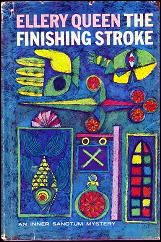
Thirty years after the fact, I still recall the anticipation with which I awaited the paperback reprint of Ellery Queen’s The Finishing Stroke. Hardcover reviews had described it as a throwback to the great masterpieces of fair-play deduction of the 1930s.
If it wasn’t quite The Egyptian Cross Mystery or The Tragedy of X, it was nonetheless a fine detective story, and I was not disappointed then, nor should readers of Carroll and Graf’s recent reprint.
Queenian scholar Francis M. Nevins has pointed to the implausibility and stylized nature of The Finishing Stroke, and objectively I can understand his viewpoint. I, however, had little trouble suspending disbelief and relishing a book whose setting is a 1929 Christmas house party with an assorted group of people stranded by that old cliche, the snow storm.
The cast of characters includes the young Ellery Queen, who has just published his first novel, The Roman Hat Mystery, and “the Maestro,” as Sgt. Velie used to call him, is in good form solving the bizarre happenings in what I considered the best book in the last two decades of the writing career of Dannay and Lee.
– Reprinted from The MYSTERY FANcier, Vol. 10, No. 4, Fall 1988
(very slightly revised).
Tue 8 Dec 2009
RIVER BEAT. Eros Films (UK) / Lippert Pictures (US), 1954. John Bentley, Phyllis Kirk, Leonard White, Glyn Houston, Patrick Jordan, Robert Ayres. Director: Guy Green.
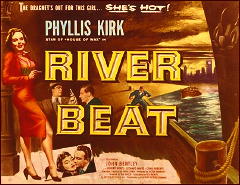
This is one of a small host of British movies made in the 1950s for which they imported a semi-star from the US, or a fading one, in order to boost its marketability in the States, and maybe boost audiences in the UK as well.
Not that Phyllis Kirk was a star that anyone in England had heard of at the time, I don’t imagine, but she had been in the US hit House of Wax (the one with Vincent Price in 3D) which I first saw when I was eleven, and I’ve been madly in love with her ever since.
A petite and decidedly pretty brunette, she had very little future in noir films (of which this is one, but only by the widest of definitions) since she was radiantly and too obviously innocent (in this case) of smuggling diamonds into England from the ocean-going liner which she’s the radio operator for.
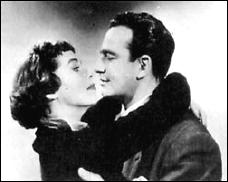
No, even though she’s arrested twice for being involved, it’s a complete frame-up, and even Detective Inspector Dan Barker (John Bentley) knows it, even though the incidents do complicate the romance and growing attraction between them.
John Bentley, among other roles, played Paul Temple three times, and John Creasey’s “Toff” twice. He’s stalwart, handsome and strong, and he’s 100% right for the three roles: this one and the other two, which I can easily tell you, even though I’ve yet to see him in the other two.
Phyllis Kirk, who of course was the primary reason I watched this otherwise fairly ordinary crime film, later when on to play Nora Charles opposite Peter Lawford for two seasons of the TV version of The Thin Man, of which I am sure I watched every episode. And some more than once. (I have the series on collector edition DVDs, and no, it doesn’t hold up very well today. Perhaps it never did.)
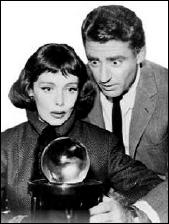
The major problem with this movie, the one at hand, though, is that the crime involved, and how it’s committed, makes no sense at all. That is, it doesn’t once the movie ends and you back up and start running it through your mind again.
While you’re watching, though, it’s suspenseful enough for me to recommend it to you on that basis alone, although some might say, and truthfully so, that the early pace is slow.
As you can see, I’m somewhat split on this, but another huge plus is the well-guided black and white photography, with much of the movie filmed on location.
All in all, it made for a decent start for director Guy Green, whose debut this was. He later went on to helm such ventures as Diamond Head, A Patch of Blue, and Luther, among a few other films whose titles you will recognize much more readily than you will this one.
Mon 7 Dec 2009
Some Mixed Hybrids [1982], Part 2
Reviews by GEORGE KELLEY:
Part 1 of this series: RANDALL GARRETT – Lord Darcy Investigates.
2.) JAMES HERBERT – The Jonah. Signet, paperback original; 1st printing, 1981. UK edition: New English Library, pbo, 1981.
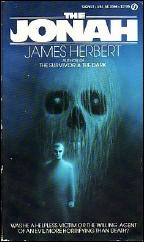
James Herbert has established himself as one of the leading British horror novelists with chillers like The Rats, The Fog, Survivor, Fluke, Lair, The Spear, and The Dark.
His latest novel, The Jonah, features undercover policeman Jim Kelso as a jinxed man, a jonah no one will work with. Through a series of flashbacks, Herbert shows Kelso’s early life in England — his abandonment at birth, the horror of the orphanage in post-WW II Britain.
Even then, death struck those around Kelso — when bullies chase him into an abandoned house, a savage death befalls them. Later, Kelso finds his step-father mysteriously dead, and a few years after that the woman he lives with dies in horrible circumstances.
When Kelso begins his career with the police, misfortune seems to strike those colleagues who work with him. Eventually, because no one will work with him, Kelso is assigned to undercover assignments where he can work alone. Even so, whenever a big bust comes down, the police involved with Kelso are killed or injured.
As a last resort, Kelso is teamed with a woman undercover agent, Ellie Shepherd. Together, they are supposed to break up a drug ring operating around a NATO base where a pilot recently crashed into the sea while taking drugs on a mission.
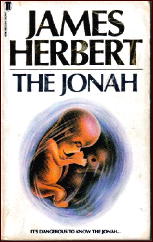
Kelso stubbornly resists a romantic involvement with Ellie and tries to discourage her from working with him on the assignment before his jinx strikes her. Although one of the pushers is murdered and an attempt is made on their lives, Kelso and Ellie get closer and closer to the secret of the drug ring.
There’s a solid presentation of police procedure in all of this, but all the while Herbert also generates a mood of rising terror through the use of his flashbacks.
The final climactic scene is chilling but lacks the impact of Herbert’s classics, The Spear and The Dark. Nevertheless, for a few hours of suspenseful reading, The Jonah will do.
– From The MYSTERY FANcier, Vol. 6, No. 2, March/April 1982
Mon 7 Dec 2009
Posted by Steve under
Reviews[6] Comments
A REVIEW BY MARY REED:
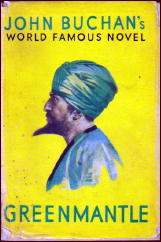
JOHN BUCHAN – Greenmantle. Hodder & Stougton, UK, hardcover, 1916. George H. Doran, US, hc, 1917. Reprinted many times in both hardcover and paperback, including: Hodder & Stoughton, UK, hc, 1947; Penguin, UK, pb, 1956; Pocket #94, US, pb, 1941.
I’ve debated whether or not Greenmantle could be classified as a mystery. Set during World War I, it certainly revolves around one: who is Greenmantle and can he be found in time to interfere with German plans to use him in their bid to grab the Middle East?
Richard Hannay, last seen just before the war in The 39 Steps and now a major in the Lennox Highlanders, is recuperating from shrapnel wounds suffered at Loos, as is his friend Sandy Arbuthnot. Anxious to return to the front line, they are instead asked to undertake a secret mission.
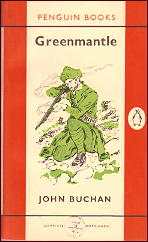
Hannay, Arbuthnot, and “sedentary dyspeptic” American John S. Blenkiron, joined later by an old friend from Hannay’s South African days, must find the mysterious Greenmantle and assess the situation so the British can take countermeasures. It is a matter of great urgency and no time can be lost.
However, they must begin the task with no clues except three words scribbled on a piece of paper — Kasredin, cancer, and v.I. In different disguises the men take separate roads to Constantinople where they will meet and begin their search, if they all arrive safely — and it’s a big if.
Along the way they encounter dangerous enemies and life-threatening situations and must use fast thinking and physical daring to even get to Turkey to begin their quest in the first place.
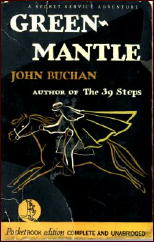
My verdict: This novel mirrors a time and society where fair play, decency, and honour were important and practiced as far as possible even in wartime. Military and intelligence gathering methods have changed since WWI and for the modern reader this gives Greenmantle a poignant air at times.
Even so, it’s a rattling good yarn, with plenty of action, excitement, and suspense, along with a dash of wit. Although I’d read the novel before, I still laughed out loud at the mental picture of Hannay in jammies and dressing gown when, due to circumstances, he is “left to receive my guest in a room littered with broken glass and a senseless man in the cupboard.”
Etext: http://www.gutenberg.org/dirs/etext96/gmntl10.txt
Sun 6 Dec 2009
Posted by Steve under
Reviews1 Comment
REVIEWED BY DAN STUMPF:
AMBROSE BIERCE – Can Such Things Be? Cassell, US, hardcover, story collection, 1893. Included in The Collected Writings of Ambrose Bierce, edited by Clifton Fadiman, Citadel Press, 1946. Reprinted several times since, both as an individual collection and in omnibus form.
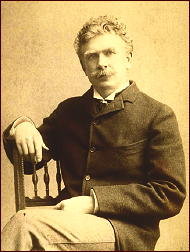
Clifton Fadiman’s 1946 collection of supernatural tales by Ambrose Bierce may not be quite top-of-the-line, but Bierce’s gift for turning the apt phrase: “The fact that Henry Armstrong was buried did not to him seem to prove that he was dead; he had always been a hard man to convince.” or “…all seemed to be waiting for something to occur; the dead man only was without expectation. ”
Or this description of an encounter with an inopportune ghost: “According to the Chinese faith, a man is like a kite: he cannot ascend to heaven without a tail. Well, while I was here that night, alone and thinking of anything but him, that Chinaman came back for his pigtail. He did not get it.” Such writing makes for memorable reading, even when the stories are unremarkable — which is often the case.
Bierce may have just been too misanthropic to convey the essential horrific humanity that must form the basis of a really scary story, except in one case: “A Diagnosis of Death” is a quick, perfect gem of a tale that ought to be required reading for lovers of this sort of thing.
Sun 6 Dec 2009
Posted by Steve under
Reviews[2] Comments
THE BACKWARD REVIEWER
William F. Deeck
INIGO JONES – The Albatross Murders. The Mystery Novel of the Month #33; digest-sized paperback reprint, 1941. Hardcover first edition: Mystery House, 1941.
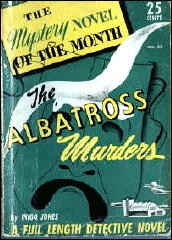
Inigo Jones, a pseudonym, wrote two mystery novels under that name: this one and The Clue of the Hungry Corpse (1939). The latter has nothing to recommend It, but The Albatross Murders I found quite enjoyable.
Somewhere in the Northeast, in a city that would have been a stop on the Underground Railroad, some young thespians are putting on a play.
On opening night, an actor who is to be shot as part of the script is shot In reality, and the player shooting him — as part of the play or for real, deliberately or because someone gave him a loaded pistol by mistake or with malice aforethought — exits the stage and keeps on going out of the theater. An oddity in the killing is there is no bullet in the dead man and no exit wound.
Besides the gaggle of actors and actresses, the deceased’s sister, who loathed him and is not very pleasant besides, was at the opening night and might have committed the, murder, if only it could be figured out how the killing was accomplished if the actor who was supposed to have shot him as part of the play didn’t do it and what became of the bullet. And what does the history of the area have to do with the murder? Nothing? Everything?
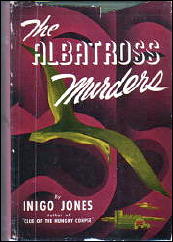
Sebastian Booth, State Police Inspector, solves the case and explains how the murder was done satisfactorily — even though it’s as Rube Goldbergish a method as I have encountered in some time — in about twenty-four. hours, but meanwhile three more people have died.
Booth is a delightful detective with a great deal of personality. He knows his mind and speaks it. In a case with many theater people, Booth says: “I’d as soon have a Gila monster around the house as an actress. Or an actor, either. I’ll be glad when this case is broken. I long for the company of a simple-hearted thief or an honest hatchet murderer.”
It is Booth’s presence that makes The Albatross Murders a mystery worth reading.
– From
The MYSTERY FANcier, Vol. 9, No. 5, Sept-Oct 1987
(slightly abridged).
Editorial Comment: Longtime readers of this blog may remember that I reviewed this book several years ago. Check out my comments here. (All in all, I agree with Bill. This is not surprising, as Bill was seldom wrong.)
Not only that, but I followed up the review with a post entitled The Compleat INIGO JONES, wherein I included every piece of information I could come up with about the author, which unfortunately did not include his (or her) real name.
Have I learned anything about Inigo Jones since then? Alas, the answer is no.
« Previous Page — Next Page »



